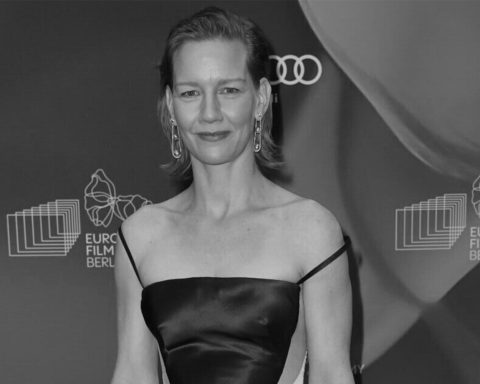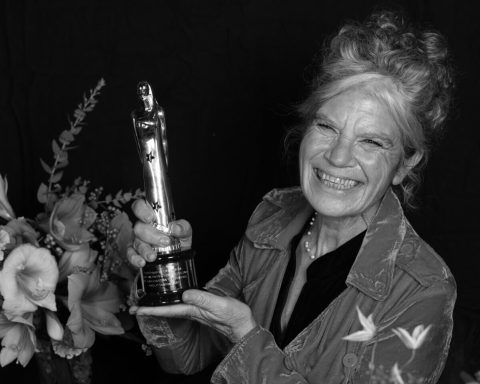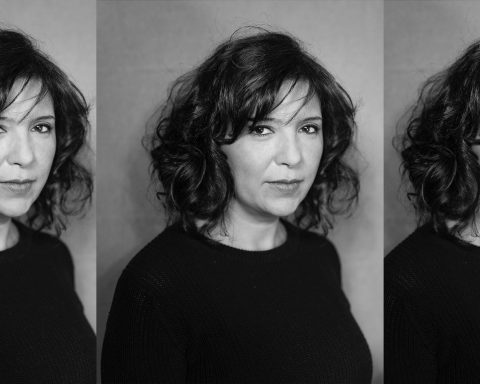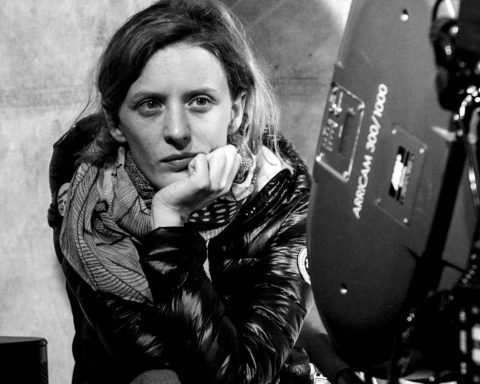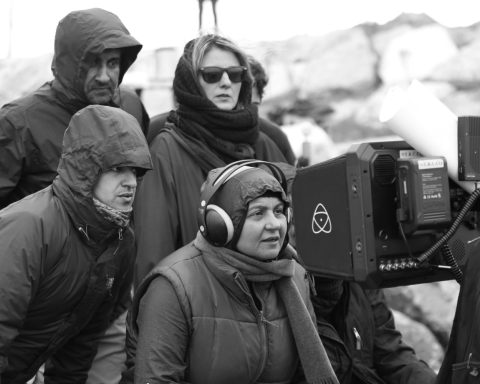Katie Davies is a Royal West of England Academician and was nominated for the 2016 Paul Hamlyn Award. She was a Jury member for the International Competition at the 2018 International Short Film Festival Oberhausen and has exhibited nationally and internationally at FACT Liverpool in 2018, Kassel Dokfest, the Bratislava International Film Festival and the Oberhausen International Film Festival in 2017 and 2015, the Sarajevo Film Festival in 2015, Border Visions, Connecticut, USA in 2012 and The Istanbul Biennial in 2009. She has contributed to several publications and her writing on practice-led research has been included in US and British publications. She is Senior Lecturer in Media & Cultural Production at the University of the West of England.
Tara Karajica caught up with her at this year’s Winterthur International Short Film Festival where she presented her short film “The Lawes of the Marches” in the “Scotland: ‘To See Ourselves as Ithers See Us’” program.
How did you get into Film? What made you want to be a filmmaker?
Katie Davies: After I left Art College, I was a designer because my first degree was in jewelry and metal work design, actually. And then, I did an M.A. in Fine Arts and that’s when I went into filmmaking. It would require a lot of photography and I love photography – I’ve been doing it in my B.A. – and that kind of lead to using digital video. But then, I would say I was still very much experimenting with the fine art practice. After that, I did a PhD in Media about British Sovereignty and contemporary bordering practices – I’m an eternal student! That was a practice-based PhD that had a written thesis as well as a film work attached to it. And I think it’s at that point that I really started properly making film works. So it was kind of a study journey between design, on the one hand, which is where you always want to design something external from you that communicates with an audience because it has a use and, on the other, fine art, that can often be very introspective and abstract. And filmmaking, for me, is somewhere between the two. I was thinking about it just the other day, actually – watching one of the film programs and realizing that’s why I went into filmmaking; I felt the work sits in-between those two disciplines, really.
You explore the construction of identities, their reflections and manipulations but you also study nationalism, violence and democracy and you form a central critique through your videos. Can you talk about that?
K.D.: It’s very strange how I came to be looking at this, but I think it was partly because when I was at University, I did a five-month exchange program in Seoul, Korea when I was eighteen and that was a real eye opener in terms of understanding societal structures because only when I was there, I understood my own because I was outside of my social boundaries. That’s when I started to be interested in states and state politics and social politics. So the first film I made was on the Korean border, in Panmunjom, and I had negotiated with the U.S. military; they took me there, which was fantastic, and that was when I first became really interested in the theater of politics and the structure of implications of violence. So different projects then grew from there.
I was looking at citizenships in Sheffield and what happens when people become British citizens, what that means and very strange things that go along with that. After that, I started looking at the repatriation of soldiers from Iraq and Afghanistan and that’s what formed my PhD thesis. Then, I looked at the Scottish referendum vote with the film that’s here – The Lawes of the Marches – which is looking at how that border was suddenly becoming visible again after it had been Politically dormant for quite a long time and at what the discussion around that was. Actually, there was a lot of latent violence in the discussion that happened around that. Subsequently, the final film that I made involved working in two prisons in Liverpool with veterans who were now offenders in prison in order to make a film about them and analyze what it means to have the dual identity of both a veteran and offender because both of those identities are ones that they don’t self-identify with and are placed upon them by the state. The state’s identity stays invisible while it dictates what theirs is. And so, I worked with the men, I taught them how to become filmmakers and we made the film together and the final edit from that, which is a four-screen installation on a single screen, is basically a negotiation over a nine-month period of us making a film together.
I think what’s quite interesting in all of these instances is that they’re a very male environment; they’re often very military environments or they have military roots and there’s something about A. being a woman and B. being an artist that these two oppositions – artist and female artist – that means that going into these very male environments I’m completely non-threatening. There are preconceptions about artists, especially within the prison, and that was quite interesting. We wouldn’t necessarily be critical if we were going to be doing an art project that’s probably quite fluffy and we actually weren’t; we were working in there and making some very critical decisions with the men and the men were learning to make very critical decisions which they were brilliant at. So I think that because I am female, I get access to places and conversations because I am non-threatening to the men that I am speaking to. I really do think that that makes a difference to me being able to have the practice that I have.
You are talking about those communities whose identities are dictated by the state, their agency to self identify being snared between political agendas and Sovereign violence. That’s what you are interested in?
K.D.: Yes. When I am talking about Sovereign violence – it’s a really broad term – but I think what I’m meaning in that instance is that just not having the opportunity to self-identify and having things imposed on you, having history re-written on the spot and losing your sense of identity, I recognize this to be Sovereign violence in some capacity.
Can you talk about The Lawes of the Marches and how it came about?
K.D.: That was a commission for the Berwick Film Festival and it was fantastic. It was a six-month residency. I went up to Berwick at around February-March time and I spent six months on the border. The brief for the film commission was to just make a film about the border because Berwick sits right between England and Scotland. But it had to be about the politics at the border at that particular time and what was very difficult was that the film opened when the polls were open for voting about whether Scotland should remain in the U.K. What was really interesting when the film opened is that I was making a film and I wasn’t sure what political context it would belong to the next day. I loved that! I thought it was wonderful, actually! And so, what it meant was that when people watched the film in that first instance, they also didn’t know. There was this amazing kind of liminal hanging in the air of what was going to happen and, of course, the next day when Scotland had remained, I saw people crying in the streets of Berwick because they really wanted Scotland to leave and then there were other people who were very happy in similar positions to Brexit. While I was there, I wasn’t quite sure what I was going to be making the film about, but as I started to meet people – members of the common riding community in Berwick – and as I started to talk to them about what these common rides were, I suddenly realized that they had the right to cross the border across the full year. They started in the spring and I was there in the spring so I managed to film over half of them. The film is, in fact, documenting over half of these ridings and is actually the most comprehensive documentation of the common rides that exists, interestingly, because nobody else has done it. I’ve been through archives of other common rides but, sometimes, there are of individual towns; there’s no-one who’s gone right across and documented all this so, as a document, it’s quite interesting. The people I met were very warm, welcoming, generous, really keen and interested in what I was doing and it wouldn’t have been possible if I hadn’t been for working with them as well. It was about documenting what these ridings are; where they’ve come from; why they happen and why they look the way they look.
Now, in contrast with Brexit, does the film get another dimension?
K.D.: Yes, it does. Interestingly, the first time I showed it in Oberhausen, there’s a particular scene at the end of the film where a woman is in the town square and is swinging the Union Jack flag around her head and she’s really shaking. You can’t see because the town square is completely full – there are thousands of people there – but the reason she’s shaking is because that tradition’s happened for seven hundred years, but that was the first time ever a woman had done it. She had the weight of seven hundred men on her shoulders as well as a responsibility, but as I filmed her, and I saw her swing this flag around her head, I remember laughing to myself behind the camera because there was something quite absurd about what she was doing as well as profound. It was amazing how it could be both things in one moment. But then, as I edited the footage, and the film had become film and the British audiences had seen it, no one ever laughed. However, when I showed it at the Berwick Film Festival, to an international audience, they laughed at that point as well and I remember I had felt like that too. I also remember thinking how images can work on you and become engrained and the meaning of them changes in time. So it was really refreshing to have an international audience looking at it to remind me of the agendas that I often forget because it’s part of my identity, unfortunately. It’s that strange thing that it’s both ridiculous and part of something I belong to as well. So when Brexit happened, a lot of the film I feel has slightly changed because of things like that, because of the flag waving and the way in which the rides look like hunts. The symbolism within it takes on new international rings. What I really want to talk about today in terms of the film is actually how these symbols are very different from what the common ridings were. The common ridings were all of the working class people from 1600, 1700, 1800 getting on horses and riding in the boundaries – it wasn’t class-related. When the Victorians came in in the mid-1800s, they made the working class watch and the middle class ride and they brought an economy around it – they also brought in fairs and fair grounds and made it have an economy to it rather than a necessity or a tradition and that has now become part of the tradition. So that’s why it looks like a hunt. That’s why there are top hats and tails and that wasn’t ever the case before. The interesting thing about tradition is you only have to copy what happened the year before.
Who is your favorite female filmmaker? And what is your favorite film by a female filmmaker?
K.D.: I really, really, really love Cleo Barnard’s work, especially The Arbor and The Selfish Giant. Whenever I hear her talk about her films and watch her films, I’m just really moved and it doesn’t actually have to do with her being a woman, it just really has to do with her being a fantastic filmmaker. The Arbor is a sensitive, thought-provoking portrayal and the way in which she has used documentary in a really innovative way is, I think, one of the reasons why I am so fond of her.
There’s been a lot of talk about women in film in the past year. What’s your stand on it and where do you position yourself within this discussion? And, would you call yourself a feminist?
K.D.: It’s a really tricky one, actually, because one of the ways I look at this is that I used to think that it shouldn’t matter if I’m male or female. What is important is the film. What is important is the people in the film. What is important is an audience coming to see that. But now, as I’m becoming a filmmaker, I’m realizing that there isn’t a leveled playing field between men and women, unfortunately. I have always thought of myself as a feminist, but in that I want there to be an equality for everybody and that hasn’t happened just yet. So the way I recognize it now is that I’m stripping it right back in quite a basic way in that I would be perfectly happy for my films to be understood in any context because what’s really, really, necessary is that they meet an audience and that an audience have the opportunity to see it. I think maybe ten years ago, we could’ve probably had a more nuanced discussion, but due to cuts, funding and the necessity of having these discussions, I think I am perfectly happy if somebody’s interested in engaging with my films, and I will support them and be part of that. I will always support female filmmakers because, as I said, it isn’t a leveled playing field. I am really interested in how both sexes manage to talk about these genders together.
What is your next project?
K.D.: I’ve just finished the prison project, and I am in the process of tidying that up, so in terms of the next project, I’m kind of looking around. I’ve got a few ideas but nothing solid yet so I am having a bit of down time and trying to get myself together to make a new film.
This interview was conducted at the 2018 Winterthur International Short Film Festival.





